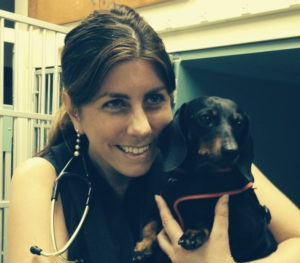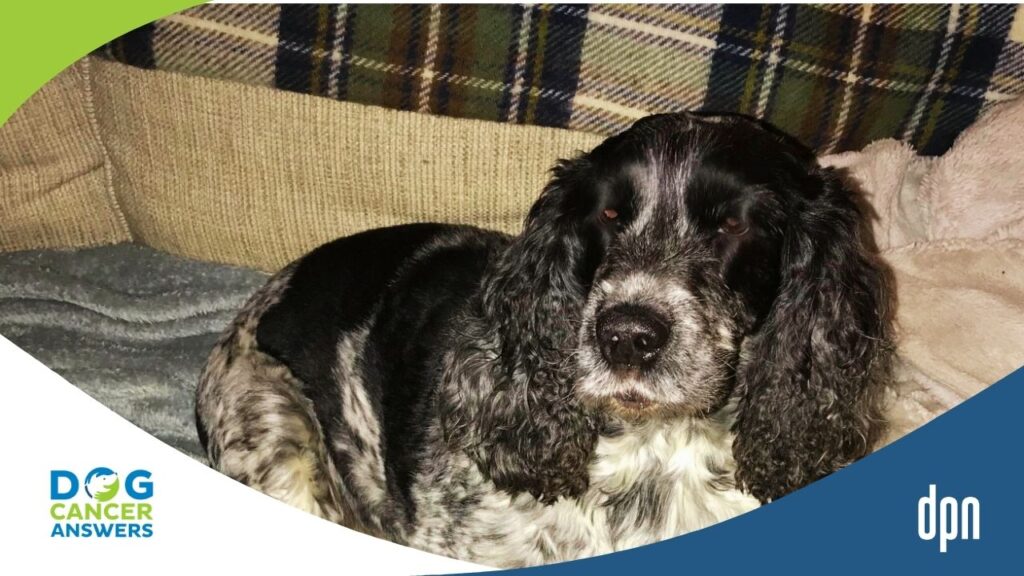EPISODE 195 | RELEASED December 12, 2022
Can Anal Gland Cancer Spread to the Stomach? | Dr. Brooke Britton
Caller Darlene just found out her dog has a possible mass in her stomach, but no symptoms of stomach cancer. What should she do?
SHOW NOTES
Darlene’s dog just had an anal gland tumor removed. Her vets were concerned that it had spread to the lymph nodes, so she had a follow-up CT scan. During that they found a possible mass in the stomach.
There are lots of things to consider in this case. Oncologist Brooke Britton weighs in on whether or not the stomach mass might be a metastasis of the anal gland tumor, or if it is a tumor at all. She also discusses the challenges of getting a diagnosis on stomach masses because of their location.
And to make things more complicated, Darlene’s Golden is 10 years old. Is it worth pursuing aggressive diagnostics if she has no symptoms of illness? Listen in to hear the pros and cons.
[00:00:00] >> Dr. Brooke Britton: Sometimes when a radiologist reads these images, they will comment about their index of concern. Do they feel like it’s a cancer? Do they feel like it’s maybe benign? Could it go either way?
[00:00:12] >> Announcer: Welcome to Dog Cancer Answers where we help you help your dog with cancer.
[00:00:19] >> Molly Jacobson: Hello, friend. Today on Dog Cancer Answers we have a question we received on our Listener Line. Darlene’s Golden Retriever had an anal gland tumor. Later, follow-up testing found another tumor that may or may not be related. To answer her question about what to do, veterinary oncologist Dr. Brooke Britton returns to the show to weigh in on the different options for her situation.
Dr. Britton, thanks so much for joining us again.
[00:00:46] >> Dr. Brooke Britton: Thank you for having me again.
[00:00:48] >> Molly Jacobson: Let’s take a listen and hear what Darlene has to say.
[00:00:51] >> Darlene: Hi there. My dog, Golden Retriever, 10 years old, had a anal gland tumor removed. Um, I was told that it had spread to his lymphatic tissue and advised to have a CAT scan done. CAT scan was done, oncologist advised me that it had not spread, so I was very happy about that, but then called the next day and advised me that there is a small tumor in his stomach lining and the lymph node is swollen.
At this point, I have no idea what to do, what is, the next step should be. I thought I could have a needle aspiration done, but I was told that that’s not possible and that, uh, I could have a biopsy done. So I am not sure at this point what I should be doing. I hate to put my dog, or have him anesthetized one more time – this will be the third time, and um, I want it to be as least invasive as possible. Thank you very much. Bye-bye.
[00:01:52] >> Molly Jacobson: Dr. Britton, poor Darlene has to deal with a stomach tumor on top of the anal gland tumor. What advice do you have for her?
[00:02:04] >> Dr. Brooke Britton: Yeah, there’s a lot to unpack in this question because we don’t know what type of anal sac tumor, anal tumor this is. It may be an anal sac adenocarcinoma, that’s the most common type of anal sac tumor that we see in dogs, but there are other types of tumors that can occur in or around the anal sac like melanoma, or lymphoma, or other tumor types. Even connective tissue tumors like sarcoma.
So it’s hard to know exactly whether the, the stomach tumor is related or not. The lesion that they see in the stomach on CT, that would be unusual for an anal sac adenocarcinoma to metastasize there. So it’s possible that on the CT scan, the stomach tumor was an, an incidental finding, meaning we weren’t expecting to find it, the dog was asymptomatic for it, and then they just saw that.
[00:03:01] >> Molly Jacobson: Oh, so the dog might have two cancers.
[00:03:05] >> Dr. Brooke Britton: That’s possible, or maybe the stomach lesion is benign and truly incidental where it’s not causing the dog an issue and it’s not going to be a problem. We don’t know. And to her point, sampling was suggested. Many times when we try to sample a stomach lining tumor minimally invasively, for example with a needle aspirate, even under ultrasound or CT guidance it can be hard to get enough cells that give us the answer for what it is.
And so that may be what her veterinarian was alluding to. Maybe the location of the tumor is difficult to access via less invasive means. Maybe they don’t feel that a needle is going to be enough to get an answer, and so they’re reluctant to try, or maybe they feel it would be a more risky procedure to try to do something like that versus a biopsy.
The other thing that she mentions is a lymph node. So is the lymph node that is enlarged near the stomach, which would be maybe a little bit more concerning for a cancerous process in the stomach that may have spread to the lymph node. But then again, if there’s inflammation in the stomach that is non-specific and causing thickening or something that looks like a, a mass-like area, for example sometimes inflammation can just cause a lymph node to be plump and mildly enlarged like that.
So again, there’s a lot that we don’t know, or at least that from this call that we don’t know all the details of. If the lymph node is closer to the anal sac tumor internally, kind of in the lower half of the body, I’d be more concerned that maybe the anal sac tumor had spread there. She also makes a point of saying that the biopsy indicated that the tumor had spread to the lymphatic system or the lymph node, but then the CT indicated that there was no metastasis.
So that’s a little bit unclear as well, what the nature of the lymphatic involvement or nodal involvement actually is and whether that’s related to the anal tumor or not. What may have been relayed to her is on the biopsy, the pathologist sometimes will indicate on a microscopic level, when they look at the tumor under the microscope, that there are tumor cells in the lymphatic vessels that supply the tumor.
So it’s possible that there was what’s called lymphatic invasion or lymphatic involvement, but we don’t know for sure if a lymph node is definitively involved and there’s definitive metastasis. Lymphatic invasion at the microscopic level implies a higher risk of that, but it doesn’t necessarily mean that it’s happened yet. We just worry that there are cancer cells inside the lymphatics, and it’s sort of like hitching a ride on a bus, at a bus stop on a highway.
You know, we sort of got on the highway and then we may be on our way to the next stop, which is the lymph node that drains the tumor, um, is usually the analogy that I will use. So just because you’re on the highway doesn’t mean you’re gonna reach your intended destination, but we worry a little bit more that we have a more directed path to get to a lymph node that drains the tumor when we see that on the biopsy, if that makes sense.
[00:06:27] >> Molly Jacobson: I think it does. So the tumor cells might be going to the lymph node but not have established cancer in that lymph node at this point.
[00:06:35] >> Dr. Brooke Britton: That’s right.
[00:06:35] >> Molly Jacobson: The fact that they’re there is not good, but they might not actually have started to really construct chaos there.
[00:06:44] >> Dr. Brooke Britton: Yeah. So essentially, when we look at what we call the metastatic cascade, which are the chain of events that tumor cells need to take and follow to establish themselves somewhere else distant from the primary tumor, there are a lot of different steps. They have to break out of their original tumor lining, they have to be able to crawl into blood vessels or lymphatics depending upon the tumor type and exhibit movement in that regard.
And then they have to survive in that environment. And if they end up being lodged in a lymph node, they have to understand how to make a home there and set up a metastatic lesion. And they can fail at any step along the way. There are a lot of things that have to go quote unquote "right" for a cancer cell and wrong for the dog or the cat who’s affected for a tumor actually to metastasize. But we worry more-
[00:07:45] >> Molly Jacobson: That gives me a little hope.
[00:07:47] >> Dr. Brooke Britton: Yeah. We worry more about the potential for metastasis when we see things like that on the biopsy, even if we don’t see obvious evidence of lymph node involvement. So I wonder if that’s what Darlene means when she says there was lymphatic involvement but then the CT seemed to ingest, suggest rather, maybe not, but then there’s this mystery lymph node that might be near the stomach. So I think there are two questions here which we don’t know the answer to and we can’t really provide the answer to without more information, which is, well first, what is the anal tumor?
I assume it’s an anal sac adenocarcinoma, but that may not be the case. So what does the biopsy say regarding that? Does it have lymphatic invasion, or do they have definite evidence that it’s already in a lymph node? Is this lymph node that they see on CT closer to the stomach, which would make me think it’s more related to the stomach issue, or is it closer to the anal sac tumor that was removed, and what is this stomach lesion?
Sometimes when a radiologist reads these images, they will comment about their index of concern. Do they feel like it’s a cancer? Do they feel like it’s maybe benign? Could it go either way? To her point about not wanting to put her dog through invasive procedures given that the dog has already been anesthetized a couple times, I completely understand that. And sometimes it is very difficult for us to know what’s going on without taking that extra step and doing something more invasive.
And if a radiologist, or her oncologist, or the team that’s working on her dog’s case feels that the nature of the lesion can’t be determined without a biopsy, unfortunately, then going in with an open abdominal surgery and getting a biopsy of that lesion and maybe that lymph node may be what has to happen if we wanna get to the bottom of it versus monitoring the dog and seeing if that lesion changes over time, especially if the dog is asymptomatic and she’s reluctant to put her dog through something very invasive.
The other question is, does the biopsy indicate that the tumor was completely removed or not. Was the tumor of higher grade? If there’s lymphatic invasion on the biopsy, that would imply, again, a, a risk of metastasis that’s perhaps higher, and so is chemotherapy indicated for that tumor or some post-surgical therapy indicated for that tumor under the circumstances?
So there are a lot of things that I don’t know based on her description that would be helpful to making those types of recommendations. But that’s sort of my, my initial overview of what we’re dealing with.
[00:10:27] >> Molly Jacobson: Yeah, it’s really stressful to have to deal with more than one cancer type problem at a time. And with a 10 year old Golden Retriever, you know, Goldens have high rates of cancer to begin with, and that, I can totally understand why Darlene might not want to put her dog under because anesthesia poses its own risks as well.
[00:10:48] >> Dr. Brooke Britton: Absolutely.
[00:10:49] >> Molly Jacobson: And surgical, recovering from the biopsy, and all of it.
[00:10:53] >> Dr. Brooke Britton: Absolutely. And this stomach thing may not even be a type of cancer. We just don’t know. You know, if the radiology report again said something to the effect of, we’re very concerned, this could be cancerous, then obviously the index of concern is higher, but it could be an incidental finding. And if the dog is asymptomatic, I think it’s reasonable if she is reluctant to do more invasive procedures for her dog to monitor that lesion, perhaps with ultrasound every couple months or every few months to see whether or not that’s progressing. And if it progresses, that would make me more concerned for a cancerous process and then she would have to make a decision – does she want to do more to find out what that is and pursue that problem, or treat her dog supportively if the dog is now symptomatic.
[00:11:41] >> Molly Jacobson: We’re going to take a short break here, but when we return, I wanna talk a little bit more about incidental findings.
We are back with Dr. Brooke Britton. When you say an incidental finding, can you say a little bit more about what that means in sort of plain language?
[00:11:59] >> Dr. Brooke Britton: Sure.
[00:12:00] >> Molly Jacobson: For those of us, yeah, that that would be helpful.
[00:12:02] >> Dr. Brooke Britton: Yeah, so an incidental finding is usually a finding on imaging, or an exam, or some other test that you don’t otherwise see outward signs of. I’ll give you a human example. My mother had melanoma in her eye and had a PET scan for staging, and they found a little tiny nodule in her lung that they didn’t think was a metastasis. It was just a single nodule. She wasn’t symptomatic for it. But because of her melanoma history, they wanted to monitor that.
And over time they did, and it didn’t change. In fact, it even got a bit smaller with time. And so that would be an example of an incidental finding. It’s something that we see that is indeterminate. We don’t know what it means, but we’re not showing signs of illness from it. And so it is something that oftentimes we can monitor if we’re not showing any symptoms relative to that lesion.
Sometimes it will be not so benign, like maybe a, an issue with a gallbladder that we find on CT, for example, something like a mucocele, which is where the bile gets really sludgy and almost impacts the gallbladder, which might require you to do something about it. Sometimes we find a high blood calcium, which might be indicative of a tumor in another area, but a dog is not yet symptomatic for it.
So it’s not always a completely benign problem that we find, but it’s just a problem that we’re not expecting to find that may or may not be related to the initial thing that we were investigating.
[00:13:39] >> Molly Jacobson: I see. Another way of saying that might be, when you start looking and scanning, you could be opening Pandora’s Box.
[00:13:46] >> Dr. Brooke Britton: Yes. And you find things that maybe are not easily interpreted. You know, plenty of benign things can look like cancerous problems on imaging and vice versa. And so often in older dogs as well, and older cats, we find incidental findings where we weren’t expecting to see it and we don’t know what it means, but because we don’t know what it means and we don’t have symptoms from that problem, we may just monitor the issue.
So it’s on our radar, so to speak, but it may not actually be impacting the primary issue that we were investigating in the first place. So, yeah. And the more sensitive tests we use, like a CT scan that goes down to a resolution of maybe a couple millimeters, for example, we’re going to find some things that may not be either here nor there, you know, for that particular animal, but because we see them, then we’re obligated to report on them and monitor them and keep an eye on them.
[00:14:43] >> Molly Jacobson: Okay. Well that’s a very helpful perspective perhaps for Darlene that the sensitivity of the CT scan allowed them to see something that maybe they wouldn’t have seen on an ultrasound, for example.
[00:14:56] >> Dr. Brooke Britton: Exactly.
[00:14:57] >> Molly Jacobson: So this thing, if her dog’s feeling well and it doesn’t seem to bother, it’s not just reasonable and understandable from a point of view of, Oh, I don’t wanna put my dog under anesthesia again, but maybe even just from a plain old relax and quality of life perspective, like it’s really okay to say, I’m not gonna worry about that now, we’ll take a look again in a few months, and if it’s a problem then, we’ll think about that problem then.
If that’s the case. If the pathologist isn’t concerned about it, it’s okay for her not to be concerned about it at this time.
[00:15:30] >> Dr. Brooke Britton: That’s true. If the radiology report is less concerning – again, we don’t know until we get a sample of that area for sure.
[00:15:37] >> Molly Jacobson: Right.
[00:15:38] >> Dr. Brooke Britton: But oftentimes the radiologist will give some level of, or index of, concern about how aggressive we may need to pursue a finding. And yet it’s still okay if we find something and maybe there is a little index of concern, but if a dog is asymptomatic, older, and depending upon how people feel about getting very aggressive in pursuing these things as their dogs age and balancing the quality of life and the other risks with what we might find and, and what those tests may yield, and those procedures may yield, it’s okay to proactively monitor.
The important thing, as with anything in the oncology world, is, is to have the conversation. So to say, Hey, we don’t know what this means, we don’t know if it’s related, but we’re gonna keep an eye on it. At the very least to have that conversation so that people are informed rather than, Hmm, it doesn’t look like anything to be worried about, so we won’t talk about it, and hope it’s nothing, and then three months later it becomes a big problem.
So, I think the most important thing is that the conversation is had and that people understand why these things can be ambiguous. So it’s, it’s not that we’re trying to be vague, but there’s only so much that we can know just by imaging alone. And so we have to take everything in the round, and usually most people are comfortable with that, they come to a decision that they feel comfortable with and know that it’s being monitored and that’s okay.
[00:17:04] >> Molly Jacobson: Right. So in terms of making a decision about whether to do a biopsy or not, what are the anesthesia risks involved for a 10 year old dog, or for dogs in general, if there’s a difference?
[00:17:17] >> Dr. Brooke Britton: In general, you know, most dogs, even older dogs – and I certainly have experience doing sedated and anesthetized procedures and recommending surgery under longer anesthesias for many dogs that are older, just given the patient population that I treat. So, you know, the anesthesia risks in general are fairly low for the majority of dogs, even older dogs. We always take into account if there are other confounding medical issues. If they have, you know, bad lung disease, or bad kidney disease, or bad heart disease, that might add increased risk under anesthesia.
Their age in and of itself is usually not a contraindication to doing anesthesia. So just being older doesn’t necessarily mean that they can’t undergo anesthesia even multiple times. I mean, we certainly have many older dogs who undergo anesthesia on a nearly daily basis for radiation for a month or so at a time when they’re getting treated for cancer – albeit a short anesthesia, but still.
So these things can be done and are done routinely. It doesn’t mean that we don’t worry about it at all, but each patient has an individual risk profile and most of the times the age is not a major factor in that risk versus other medical issues that a dog may have.
[00:18:34] >> Molly Jacobson: That makes sense. So Darlene has some questions to get clarity on from her specialist and then can make her decisions with more confidence, it sounds like you’re saying.
[00:18:46] >> Dr. Brooke Britton: Yeah, absolutely.
[00:18:48] >> Molly Jacobson: Yeah. Thank you so much for joining us today, Dr. Britton, and helping us help Darlene. We appreciate it.
[00:18:54] >> Dr. Brooke Britton: Oh, my pleasure. My pleasure.
[00:18:57] >> Molly Jacobson: And thank you, listener. If you have a question like Darlene did, you can always give us a call at (808) 868-3200 and leave a message. We might choose your question to feature on a future episode of Dog Cancer Answers. You can always find past episodes of our show and the show notes for every episode on dogcancer.com.
I’m Molly Jacobson, and from all of us here at Dog Podcast Network, I’d like to wish you and your dog a very warm Aloha.
[00:19:31] >> Announcer: Thank you for listening to Dog Cancer Answers. If you’d like to connect, please visit our website at dogcanceranswers.com or call our Listener Line at (808) 868-3200. And here’s a friendly reminder that you probably already know: this podcast is provided for informational and educational purposes only. It’s not meant to take the place of the advice you receive from your dog’s veterinarian.
Only veterinarians who examine your dog can give you veterinary advice or diagnose your dog’s medical condition. Your reliance on the information you hear on this podcast is solely at your own risk. If your dog has a specific health problem, contact your veterinarian. Also, please keep in mind that veterinary information can change rapidly, therefore, some information may be out of date.
Dog Cancer Answers is a presentation of Maui Media in association with Dog Podcast Network.
Hosted By
SUBSCRIBE ON YOUR FAVORITE PLATFORM
Topics
Editor's Picks
CATEGORY








